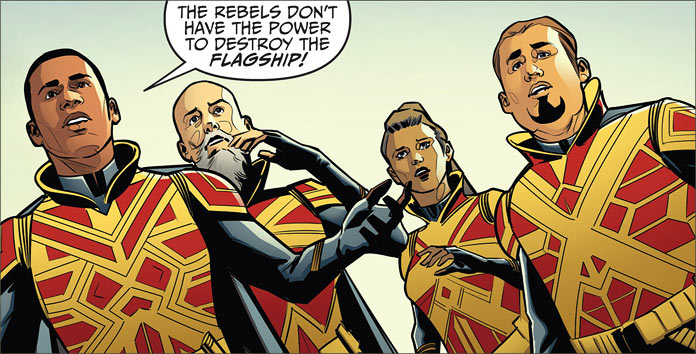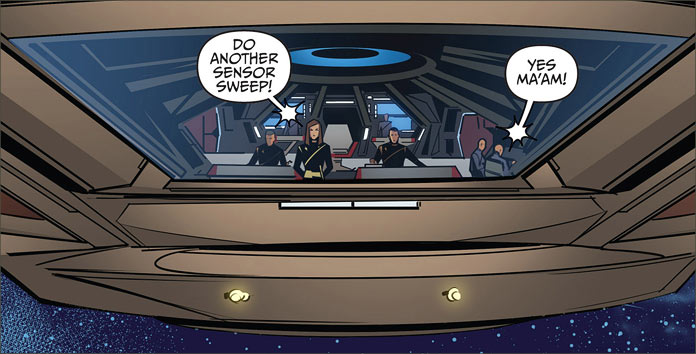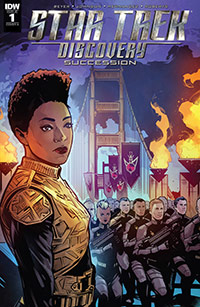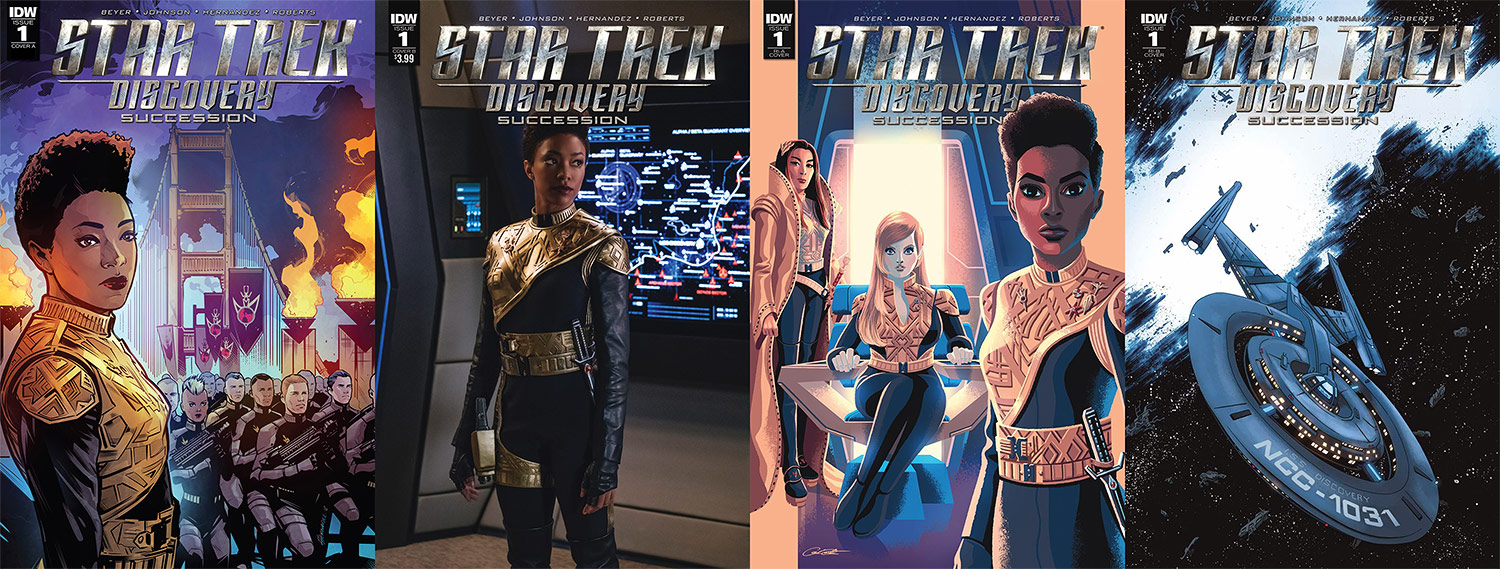I think the Mirror Universe would bring out the bad in me.
I’m a fairly harmless guy. I read comics, interview sci-fi actors and have an enormous collection of Star Trek toys and autographs. In fact, much to my wife’s chagrin, I have an entire study in my basement dedicated to all this stuff. I’m a typical Trek nerd and I’m even kind to small animals and children.
But I often wonder: how twisted would I be in the Mirror Universe?
That’s the appeal of Star Trek: Discovery – Succession #1. The Mirror Universe is such a great setting for a Star Trek story and it is such a fan-favourite. We are fascinated by the warping and sometimes savage changes to the heroic characters we already know.
Automatically, we are drawn to this milieu and the events of the end of Discovery Season 1 have prepared us for an exciting look at what happens in the Mirror Universe after the USS Discovery made it back to its own universe.
Recapping the events, the imperial flagship Charon has been destroyed, and the Emperor is believed dead. This has created a power void in the Terran Empire, and one that the rebels are eager to fill. We meet Prince Alexander, Georgiou’s royal cousin who wastes no time in ascending to her throne.

A racial purist, his scheme to enforce his control over the Empire rests in the elimination of all non-humans – a scheme that is met with skepticism in his own ranks. Furthermore, the command crew of the ISS Shenzhou has undergone a few changes and we even meet a version of Harry Mudd who surprises us with his level of humanity.
(One question, however: we saw Owosekun die in “What’s Past Is Prologue,” how is she alive aboard the Shenzhou?)
There’s greater insight into the relationship between Mirror Gabriel Lorca and Michael Burnham in scenes set a year prior to the insurrection. Both of these characters are ruthless and double-natured with regards to their ambition and even their involvement with each other. They are truly the inverse of the characters in the ‘prime’ universe and are fascinating.
Like I said before, there’s the appeal. We are truly intrigued in what storylines can develop from the opposites of familiar characters. Their decisions are dictated by their personalities, are they not? But what I find really remarkable is that while ‘our’ Michael Burnham — a dedicated Starfleet officer raised in a Vulcan logic-rich environment — made a career-destroying decision on an impulsive decision that set the Federation to war, the mirror Burnham looked to make a decision on the same level of scale… one that might actually bring some sort of order to the Terran Empire.
A true inverse. It’s an awesome parallel that is subtle and intricate in its assembly because there is a superb writing team at the helm of this book with an expanded perception on story crafting that encompasses two mediums.

Mike Johnson, veteran comic writer who knows his medium inside and out, teams up with Discovery writer Kristen Beyer, who brings the inside scoop from the series writers’ room for story continuity.
Discovery writer/producer Ted Sullivan recently addressed how the team considers tie-in storytelling when crafting episodic scripts, in response to this month’s Discovery Annual 2018:
Well, I look at things this way – it’s canon unless we do something that invalidates it (b/c we find a story we NEED to tell that contradicts it). But we here at @StarTrekRoom think it’s a beautiful story and treating it as canon!
— Ted Sullivan (@karterhol) April 6, 2018
This is important to note. Not only does it recognize the importance of comic storytelling as an extension of the franchise, but it also indicates a greater freedom and range of opportunity for unique storytelling by the show’s writers. The continuum of the show can now be expanded through their influence into the comic realm as well as on the show.
I don’t know if this is intentional, or if this is an experiment, but it certainly does make for a really unique comic and comic-reading experience.
Then there’s the visual side of this book too.
- The interior art is superbly handled by Angel Hernandez who also provides the ‘A’ cover. It’s a thoughtful cover that provokes a totalitarian attitude and reminds us that this is not the Federation we know. Burnham is resplendent in her Imperial uniform, which I have to confess, is probably a lot more practical than the ones we were introduced to in the original series.
- Cover ‘B’ is a photo cover. As I’m usually opposed to photographs on a comic cover, I can’t say I’m too excited by it. However, in this instance, as we are looking at incorporation of the comic story to apply to the television domain, in this case, it may actually be relevant.
- George Caltosudas provides the art for the retailer incentive ‘A’ cover. While I am not a fan of Mary Wiseman’s character, Caltsoudas’s presentation of “Captain Killy” in command certainly does not lack for glamour.
- Declan Shalvey’s retailer incentive ‘B’ cover is absolutely splendid! What a glorious representation of the ISS Discovery in attack position; it’s dynamic, energetic and cinematically exciting.

The advantage of cinematically connecting this book to the show is clear: the exploration of alternative story threads not only adds to the enjoyment of the show, but canonical legitimacy adds to the authenticity and entertainment value of the comic as well. It’s not a simple thing to present two versions of the same character on screen, but it is far easier to do that in a comic book.
We get to see the twisted variants of the Mirror Universe (or the redeeming reverse characters of the villains in the Prime Universe) in all their sadistic glory but in a way that adds to the fabric of the television series too.
What a great comic age we live in when these two mediums work together. Huh… after thinking about it, in the Mirror Universe, I probably wouldn’t like Star Trek. How savage.


